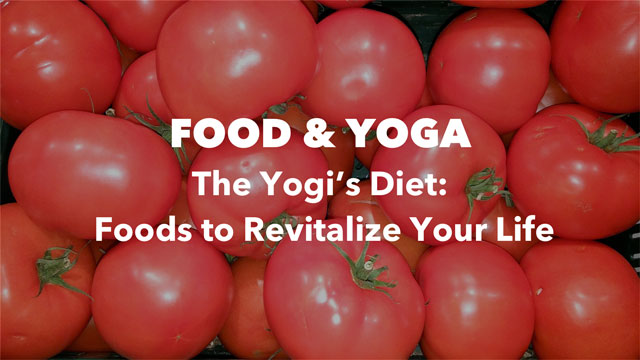The Yogi’s Diet: Foods to Revitalize Your Life

Even though ancient yogic scriptures don’t have any strict nutritional guidelines, yogis are very particular about what they consume. Food is placed on a high pedestal by yogis as they consider food to be the source and the mother of Prana, or life force.
For a yogi, eating is as crucial as the practice of yoga itself. Eating is not regarded merely to be a means of nutrition for the body’s tissues, organs and muscles. Rather, yogis understand that food forms the biochemistry of our thoughts and therefore the basis of our mind, our emotions, and finally the human soul too. Whether we realise it or not, what we eat affects the way we feel and hence, to maintain a calm and balanced mind, we need to be mindful of the food choices we make.
A truthful yoga practice would NOT mean that we immerse ourselves into asanas and pranayamas on one hand and then on the other hand, we live on a diet that includes primarily, sugar, soda, caffeine, or processed and junk food. Conversely, people also often wrongly assume that a pure vegan diet is only yogic diet. Let’s try to understand in depth the rules and intricacies of a yogic diet.
The yogic philosophy for food
Ancient Yogic literature, ( be it Patanjali’s Yoga Sutras or The Bhagavad Gita) , does not prescribe a specific diet for yogis. However, there are certain diet principles that yogis should abide by. Yogis should eat foods that make them feel light and revitalized with an enhanced level of clarity. Which means – the food that we eat should have the same effect on us, that the physical practice of yoga brings about.
In Yogic and Ayurvedic tradition, foods are believed to have energy associated with them, which brings certain qualities or gunas to them. There are three gunas – Raja, Tama, and Sattva. Rajasic foods are the ones which are hot, spicy, salty, or bitter, such as coffee and hot peppers. They overstimulate the brain and make one hyperactive.
On the other hand, Tamasic foods (also refereed to as “dead foods”) are considered to have lost all their prana. All processed and frozen foods come under this category and they usually consist of elements like carbohydrates, sugar, and artificially synthesized substances, which are essentially, no less than poison for the body.
But, what we are really interested in, is the third guna, Sattva. Yogis consider Sattvic foods as the purest of all. A Sattvic diet nurtures not just the body, but the mind and the soul of the yogi too. As opposed to Tamasic food, a Sattvic diet is filled with prana to the brim and is composed of foods in their most natural form, fresh and teeming with energy.
Sattva signifies complete awareness, love, and peace, which is equivalent to a higher state of consciousness. The precept of ahimsa or non-violence, forms the foundation of Sattva and advocates non-killing of animals, as much as possible. However, we are definitely allowed to ponder, assess and come to our personal choices and ethics while implementing these principles.
What foods qualify for a yogic diet?
Yogis should opt for a balanced diet that is hugely lacto-vegetarian and that has a positive effect on physical health as well as on thoughts and emotions. To properly exploit the benefits of our yoga practice, a yogic diet is essential, as, it augments the goal of spiritual well-being that yoga practitioners so passionately seek.
A lacto-vegetarian diet means that, apart from vegetarian food, one is allowed to have dairy products and honey. As we advance in our practice, we do not have to force ourselves into vegetarianism. It should come, and usually comes, naturally. Vegan foods help us attain the calm, light and invigorating feeling that should accompany our asanas and pranayama practice.
Here are a few foods we should be including in our diet if we want to go the yogic way.
- Fresh fruits
- Vegetables- but onions and garlic in moderation(They fall under Tamasic foods)
- Whole grains in moderation – oats, wheat, rice
- Pure fruit juices
- Milk and ghee in moderation
- Beans, tofu, lentils
- Nuts and legumes
- Sprouted seeds
- Herbal teas
- Sweet Spices – cardamom cinnamon, turmeric, ginger,basil etc.
- Honey in moderation
The main concern with a vegetarian diet is the possibility of a protein deficiency. However, if we include a good amount of nuts, dairy products, legumes, and green leafy vegetables, we will be able to take care of our protein needs.
It will be extremely helpful if we can maintain regular intervals between our meals. Also, keep a gap of at least two hours of no eating before we begin our yoga class and also before we sleep.
Conclusion
It may not be possible to make a huge shift in our dietary habits all at once, but always remember that small changes every day add up to prominent changes in our overall well-being. Keep in mind that even if these are the basic requirements of a yogic diet, you as an individual, may have your own unique requirements, different from others.
Furthermore, your own requirement may vary from time to time. For instance, you may be deficient in iron at the present moment and so, require to tweak your diet accordingly. What your body will require a year later might be very different from what it requires today. It also depends on which yogic values and precepts strike a chord with you. We all need to listen to our mind and body while making choices within our yogic diet.
AUTHOR BIO
Sapna Sondhi Dutt has been teaching yoga since 2001. She started her own yoga studio in Gurgaon (India).









